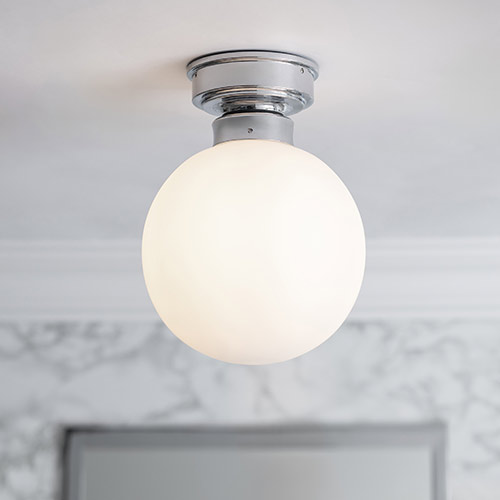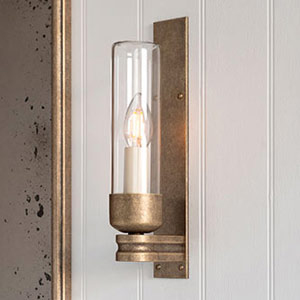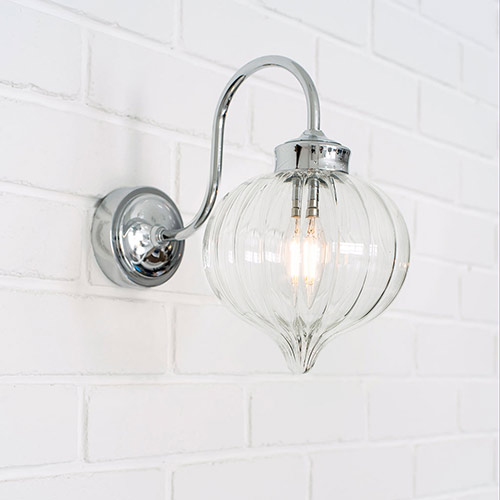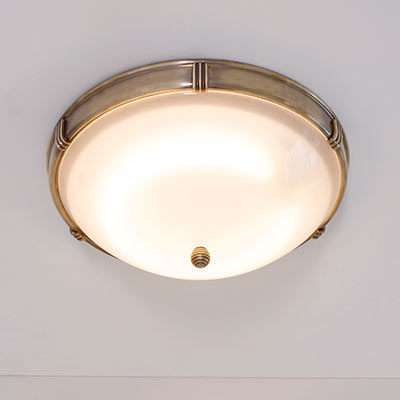DefaultPageTemplate.ascx

EVERYTHING YOU NEED TO KNOW ABOUT
BATHROOM LIGHTING
Can I use any lights in a bathroom?
No. Bathroom lights need to conform to current safety regulations to ensure they are safe to use in a damp environment where there is an increased risk of electrical shock for users due to being close to water.
For more information, see our guide IP Ratings Explained.
What lights should I have in a bathroom?
It is recommended that all bathroom lights have an IP rating of at least IP44 which means the electrical parts are concealed against water intrusion.
All our bathroom lights are designed with safety in mind so all have an IP ratings of 44 as required, as standard for bathroom splash zones.
Read more in our guide IP Ratings Explained.
Can you use fabric shades in a bathroom?
Yes you can use fabric lamp shades in a bathroom although you may find that over a long time, in high use areas, they may develop slight mildew.
If you are worried, choose synthetic fabrics that are more water resistant, or opt for linen that naturally wicks away heat and water.
What is an IP rating?
IP ratings are a 2 digit classification given to lights during testing to show how much protection they give against solids like dust and water.
The first digit deals with particles like dust, the second with water. The higher the digit the better the protection.
For more information, see our guide IP Ratings Explained.
What are bathroom zones?
Bathrooms are divided into zones 1- 3 according to how much water vapour there is likely to be in that area, with zone 1 being directly above or beside a bath, or inside a shower unit, and zone 3 being furthest away from a water source.
Zone 2 is the splash zone around wash basins, bathes and outside shower units where many bathroom lights are required for good lighting. Lights in these areas need to have an IP rating of at least 44.
What kind of lighting do I need in a bathroom?

Ambient – for good overall lighting that fills the room.

Task – focused light for working or grooming.

Accent – decorative light for warmth, atmosphere and an even balance of light.
What do I need to consider for bathroom lighting?
Keep it consistent – multiple sources of light for an even spread and cohesive look.
Shape & style – your light’s dimensions will influence the look and feel of the space so make sure you think about the aesthetic you wish to achieve. Go for subtle, streamlined lights for a modern, minimalist appeal. Or choose opulent designs for statement lighting that will take centre stage.
Bathroom mirror lights - the most important spot in your bathroom after the bath or shower, your mirror is a natural focal point that will draw the eye so is an ideal place to fit some beautiful bathroom wall lights. They will diffuse light to banish dark shadows, add layers of light for a soft, calming effect and make the room seem brighter and bigger.
For inspiration, see our Blog: Guide to the best bathroom mirror lights
Discover more about bathroom mirror lights in our Detailed Guide to Bathroom Mirror Lights
How many bathroom lights do I need?
That depends on the size and layout of your bathroom, but generally we recommend at least one ceiling light fitted fairly centrally in the space – or two for a larger bathroom with a second ceiling light fitted above the bath or shower.
You will need at least 1 wall light if fitted above a bathroom mirror, or preferably 2 fitted either side of the mirror.
If you have the space, we suggest adding a third light source in your bathroom to give an even spread – this could be coloured LED lighting to create a the right mood, or another wall light to create soft layers of light.
For inspiration and a guide to mirrors, see our Blog: 7 Mirrors to transfor your space
To find out more about lighting a small bathroom, read our Blog: How to light a small bathroom.
What wall lights are best for bathrooms?
Look for well made wall sconces with an IP rating of 44 in a durable finish that complements your decor. For bathroom lighting ideas, see our range of Bathroom Wall Lights. Some of our long standing customer favourites include:

The Cheltenham Wall Light
Best seller.
Perfect for bathroom mirrors.
Made in brass and nickel finishes.
Suits modern or period homes.
Art deco style.

The Raydon Wall Light
Best seller.
Perfect for bathroom mirrors.
Available with clear, fluted & opal glass.
Made in brass, nickel & painted finishes.
Suits any style of bathroom.

Mia Bathroom Wall Light
Best seller
Fit above or beside a bathroom mirror.
Suitable for small spaces.
Choice of brass and nickel finish.
Decorative tear drop design
What ceiling lights are best for bathrooms?

Ava Bathroom Pendant
Best seller.
Elegant pendant fitting.
Perfect ambient lighting.
Durable brass & nickel finishes.

Grosvenor Light
Opal glass for diffusing light.
Flush mount ceiling fitting.
Perfect for low ceilings & small spaces.
Choice of brass or painted finishes.
Where should I fit bathroom wall lights?
One of the best places to ensure you have good quality lighting to provide ambient light for washing, dressing and grooming is to fit 2 bathroom lights either side of a bathroom mirror, or to hang 1 light above it.
For more suggestions and top tips see our Detailed Guide to Bathroom Mirror Lights
How many lights for a small bathroom?
In a smaller space, you may only need a central ceiling light and a bathroom mirror light, especially if used alongside a bathroom mirror that will reflect natural light and make the space seem larger and deeper.
For a handy guide, see our blog: How to light a small bathroom.
What are the best materials for bathroom fittings?
Metals in a durable finish make the best fittings for bathrooms because they will ensure the product lasts a long time in a damp environment.
Our signature antiqued brass is a beautiful, natural finish that darkens over time but does not rust, so is perfect for a bathroom setting. Some of our brass bathroom fittings are given a coating of clear lacquer for added durability.
Nickel is another finish that is popular in bathrooms. This bright, reflective finish is made from nickel plating brass for a rust-free finish and adding a flash layer of chromium to ensure longevity.
Products in our painted finishes are also suitable for bathrooms as the paint is applied in a powder coating process that creates a smooth, hardwearing surfaces.
For more inspiration, browse our Bathroom Ranges
To read more, see our Product Finishes guide.
WHERE DO I FIT BATHROOM MIRROR LIGHTS?
ABOVE THE MIRROR
As a rule, a bathroom mirror light to be placed centrally at least 5cm above the top of the mirror frame and around 15-20 cm above the hairline of the tallest person in your family.
Avoid placing lights directly over the mirror at a very low height, as this can cast unflattering shadows on your face.
BESIDE A MIRROR
Wall lights should be placed at, or a little above, eye level, generally around 155 - 165cm (5.5 to 6ft) from floor level.
Fit them 20-30cm away from the mirror's edge to ensure shadow-free illumination.
If your bathroom has a high ceiling, or you have a vertically hung mirror, you may need to adjust these heights upwards.
What are the latest trends in bathroom lighting?
How bright should a bathroom be?
It is essential that bathroom lighting has enough bright, ambient light for bathing, dressing and washing by as well as sufficient task lighting for grooming, and ideally, some accent lighting to create the mood or atmosphere you wish for.
Brightness levels are measured in lumens.
For bathrooms we recommend using LED bulbs with a lumens of at least 400 – 460 lm (equivalent to a 40W incandescent bulb) for accent lighting and 800 -850lm (60W bulb) for lights providing ambient and tasking light.
For more information about bulbs, brigtness and colour, see our handy Knowledge Base guide, Everything You Need to Know About Bulbs
Should I have warm or cold light in a bathroom?
That is really up to you and the ambience you wish to achieve. Bulbs that give off soft, yellow light will make the space seem more traditional and cosier, while bulbs with white light will make it the room seem brighter and more modern.Light temperature is measured in Kelvin.The lower the Kelvin of a bulb, the more red light it produces. The higher the Kelvin, the bluer the light.
2,700-3,000 Kelvin: Has a warm tone and is good for ambient light, typically from incandescent and Edison bulbs.
3,000-4,000 Kelvin: A soft white light in this range is often the best light bulb for bathroom tasks. They provide clarity without being harsh.
4,000-5,000 Kelvin: This neutral white light with more blue tones is found in halogen and LED bulbs and is best for applying makeup.
5,000+ Kelvin: Created by daylight lighting or LED bulbs, this bright white with sometimes cool, blue tones is good for high-detail visibility
For more information about bulbs, brigtness and colour, see our handy Knowledge Base guide, Everything You Need to Know About Bulbs